1999 SUBARU LEGACY air filter
[x] Cancel search: air filterPage 227 of 1456
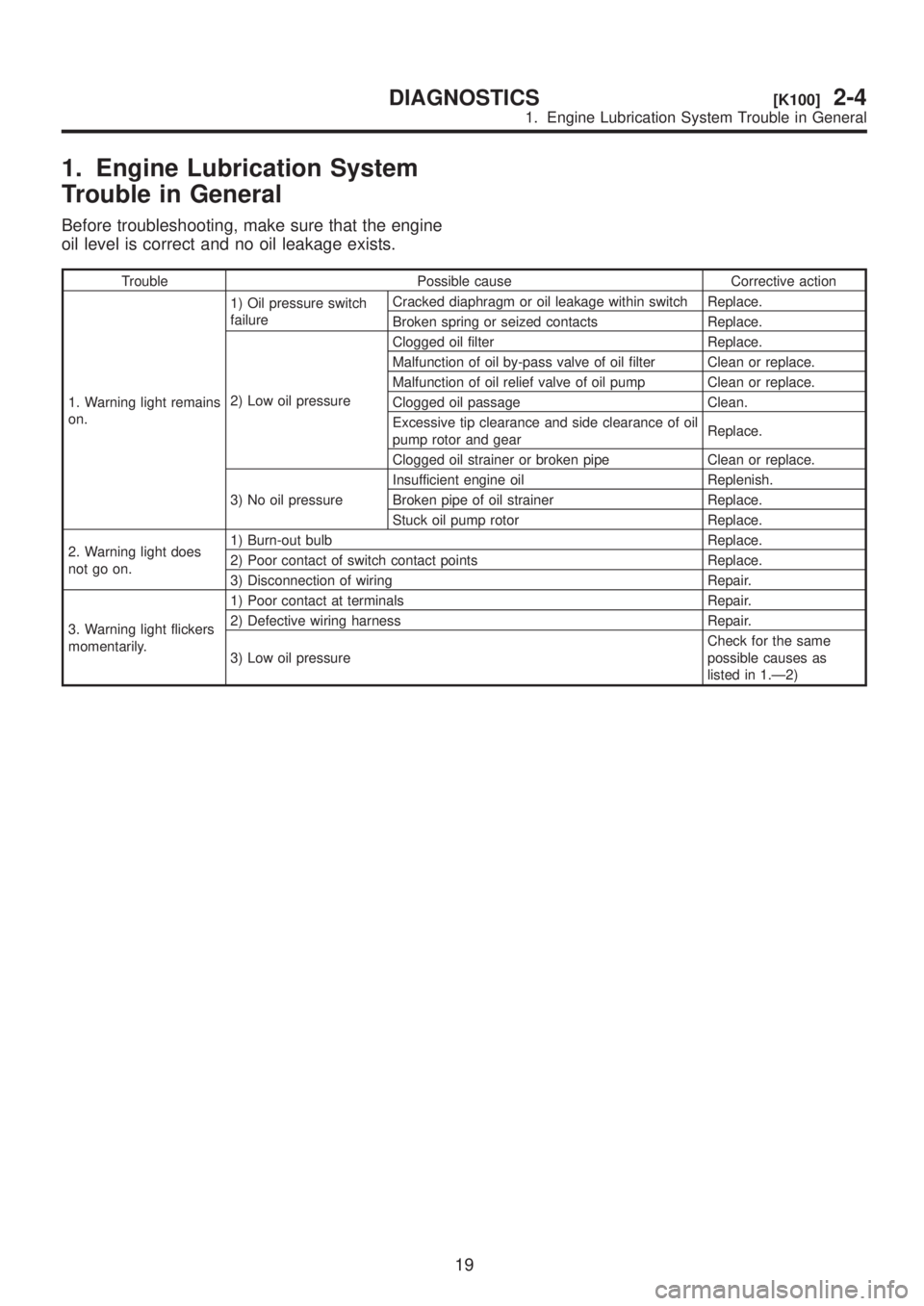
1. Engine Lubrication System
Trouble in General
Before troubleshooting, make sure that the engine
oil level is correct and no oil leakage exists.
Trouble Possible cause Corrective action
1. Warning light remains
on.1) Oil pressure switch
failureCracked diaphragm or oil leakage within switch Replace.
Broken spring or seized contacts Replace.
2) Low oil pressureClogged oil filter Replace.
Malfunction of oil by-pass valve of oil filter Clean or replace.
Malfunction of oil relief valve of oil pump Clean or replace.
Clogged oil passage Clean.
Excessive tip clearance and side clearance of oil
pump rotor and gearReplace.
Clogged oil strainer or broken pipe Clean or replace.
3) No oil pressureInsufficient engine oil Replenish.
Broken pipe of oil strainer Replace.
Stuck oil pump rotor Replace.
2. Warning light does
not go on.1) Burn-out bulb Replace.
2) Poor contact of switch contact points Replace.
3) Disconnection of wiring Repair.
3. Warning light flickers
momentarily.1) Poor contact at terminals Repair.
2) Defective wiring harness Repair.
3) Low oil pressureCheck for the same
possible causes as
listed in 1.Ð2)
19
[K100]2-4DIAGNOSTICS
1. Engine Lubrication System Trouble in General
Page 367 of 1456
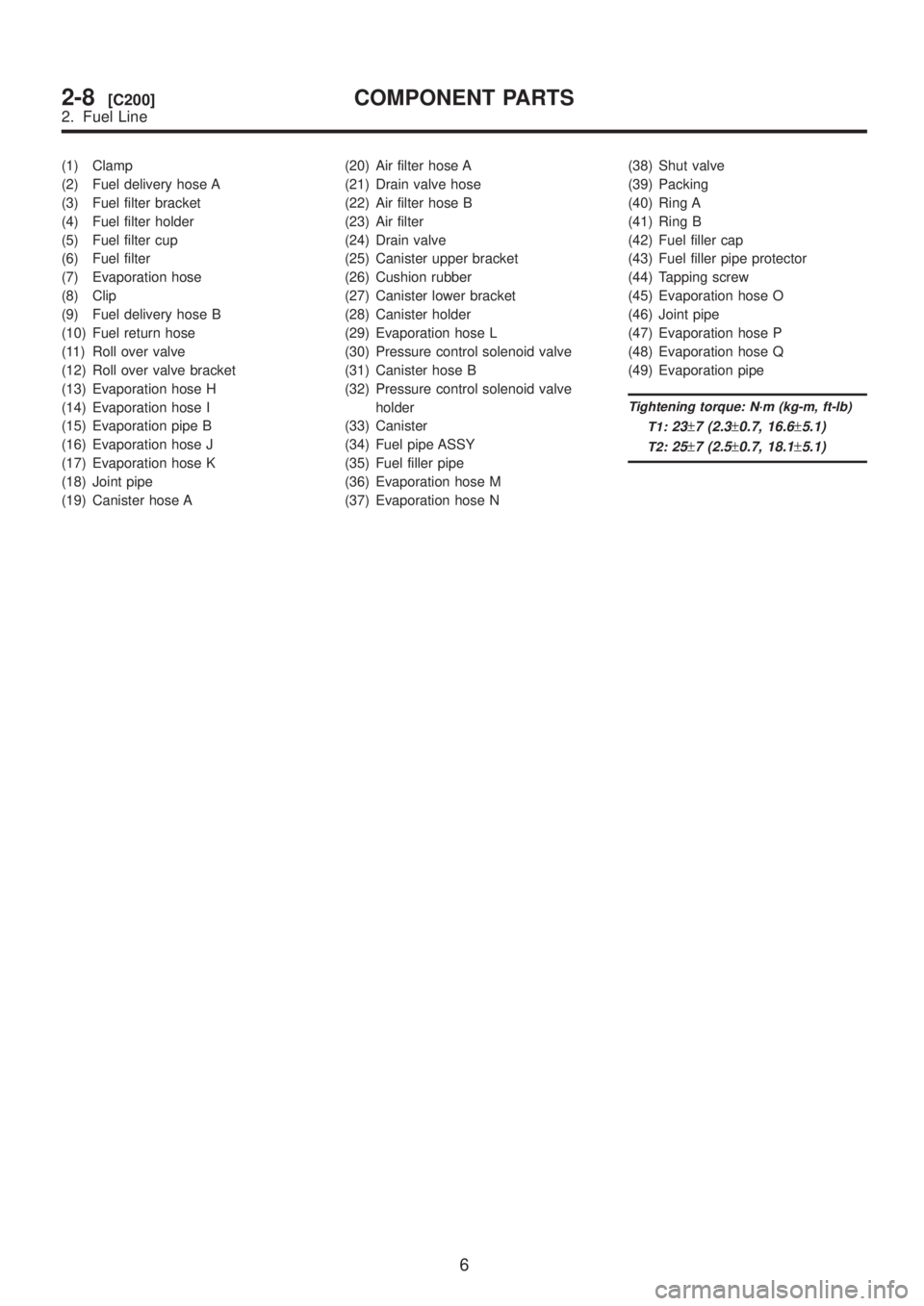
(1) Clamp
(2) Fuel delivery hose A
(3) Fuel filter bracket
(4) Fuel filter holder
(5) Fuel filter cup
(6) Fuel filter
(7) Evaporation hose
(8) Clip
(9) Fuel delivery hose B
(10) Fuel return hose
(11) Roll over valve
(12) Roll over valve bracket
(13) Evaporation hose H
(14) Evaporation hose I
(15) Evaporation pipe B
(16) Evaporation hose J
(17) Evaporation hose K
(18) Joint pipe
(19) Canister hose A(20) Air filter hose A
(21) Drain valve hose
(22) Air filter hose B
(23) Air filter
(24) Drain valve
(25) Canister upper bracket
(26) Cushion rubber
(27) Canister lower bracket
(28) Canister holder
(29) Evaporation hose L
(30) Pressure control solenoid valve
(31) Canister hose B
(32) Pressure control solenoid valve
holder
(33) Canister
(34) Fuel pipe ASSY
(35) Fuel filler pipe
(36) Evaporation hose M
(37) Evaporation hose N(38) Shut valve
(39) Packing
(40) Ring A
(41) Ring B
(42) Fuel filler cap
(43) Fuel filler pipe protector
(44) Tapping screw
(45) Evaporation hose O
(46) Joint pipe
(47) Evaporation hose P
(48) Evaporation hose Q
(49) Evaporation pipe
Tightening torque: N´m (kg-m, ft-lb)
T1:
23±7 (2.3±0.7, 16.6±5.1)
T2:25±7 (2.5±0.7, 18.1±5.1)
6
2-8[C200]COMPONENT PARTS
2. Fuel Line
Page 395 of 1456

1. Fuel System Trouble in
General
Trouble and possible cause Corrective action
1. Insufficient fuel supply to the injector
1) Fuel pump will not operate.
qDefective terminal contact.Inspect connections, especially ground, and
tighten securely.
qTrouble in electromagnetic or electronic circuit parts. Replace fuel pump.
2) Lowering of fuel pump function. Replace fuel pump.
3) Clogged dust or water in the fuel filter. Replace fuel filter, clean or replace fuel tank.
4) Clogged or bent fuel pipe or hose. Clean, correct or replace fuel pipe or hose.
5) Air is mixed in the fuel system. Inspect or retighten each connection part.
6) Clogged or bent breather tube or pipe.Clean, correct or replace air breather tube or
pipe.
7) Damaged diaphragm of pressure regulator. Replace.
2. Leakage or blow out fuel
1) Loosened joints of the fuel pipe. Retightening.
2) Cracked fuel pipe, hose and fuel tank. Replace.
3) Defective welding part on the fuel tank. Replace.
4) Defective drain packing of the fuel tank. Replace.
5) Clogged or bent air breather tube or air vent tube.Clean, correct or replace air breather tube or air
vent tube.
3.Gasoline smell inside of compartment
1)Loose joints at air breather tube, air vent tube and fuel filler
pipe.Retightening.
2) Defective packing air tightness on the fuel saucer. Correct or replace packing.
3) Cracked fuel separator. Replace separator.
4. Defective fuel meter indicator
1) Defective operation of fuel meter unit. Replace.
2) Defective operation of fuel meter. Replace.
5. Noise
1) Large operation noise or vibration of fuel pump. Replace.
NOTE:
When the vehicle is left unattended for an
extended period of time, water may accumulate in
the fuel tank.
1) To prevent water condensation:
ITop off the fuel tank or drain the fuel completely.
IDrain water condensation from the fuel filter.
2) Refilling the fuel tank:
Refill the fuel tank while there is still some fuel left
in the tank.
3) Protecting the fuel system against freezing and
water condensation:
ICold areas
In snow-covered areas, mountainous areas, skiing
areas, etc. where ambient temperatures drop
below 0ÉC (32ÉF) throughout the winter season,
use an anti-freeze solution in the cooling system.Refueling will also complement the effect of anti-
freeze solution each time the fuel level drops to
about one-half. After the winter season, drain water
which may have accumulated in the fuel filter and
fuel tank in the manner same as that described
under affected areas as below.
IAffected areas
When water condensation is notched in the fuel
filter, drain water from both the fuel filter and fuel
tank or use a water removing agent (or anti-freeze
solution) in the fuel tank.
4) Observe the instructions, notes, etc., indicated
on the label affixed to the anti-freeze solution
(water removing agent) container before use.
27
[K100]2-8DIAGNOSTICS
1. Fuel System Trouble in General
Page 544 of 1456
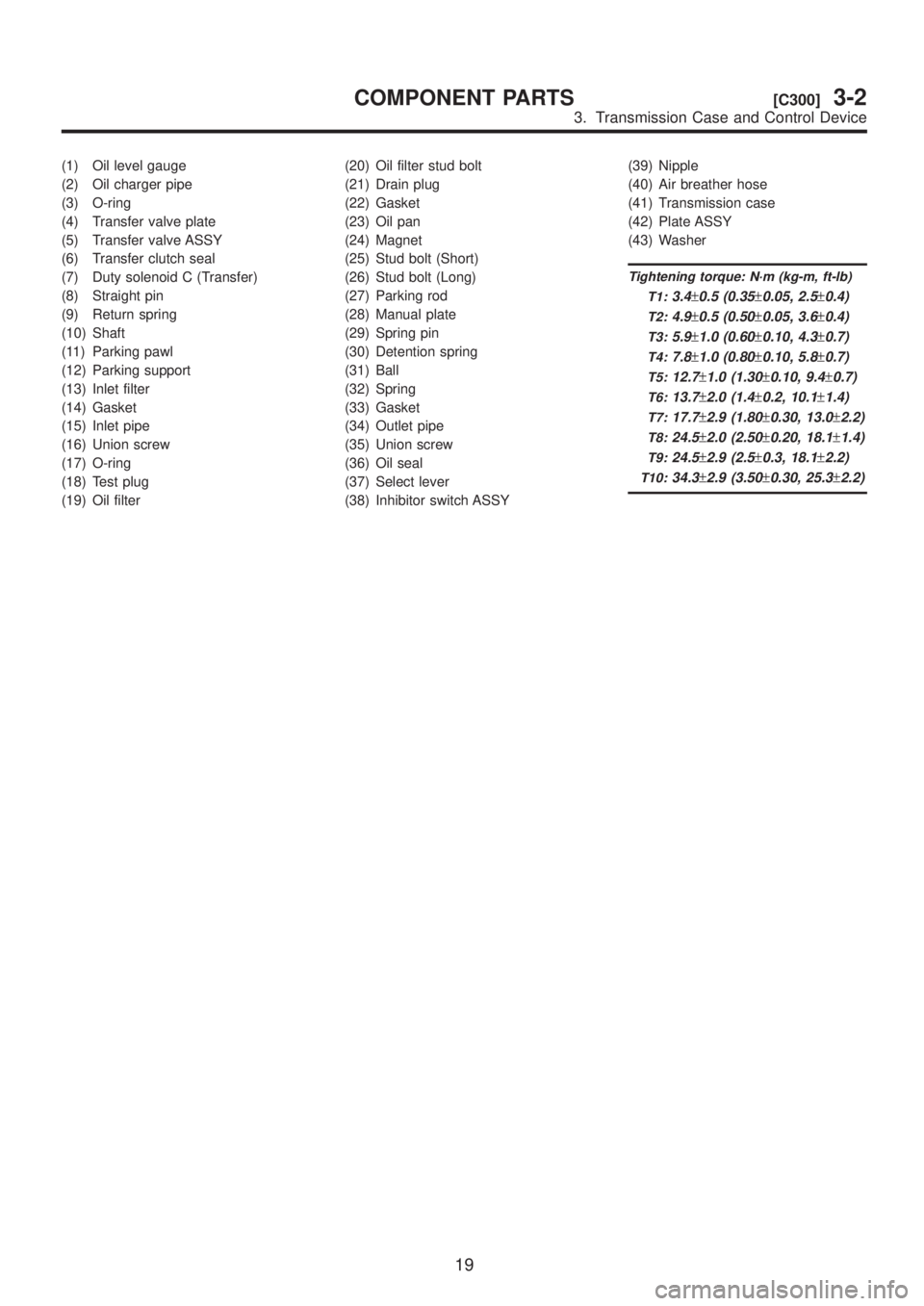
(1) Oil level gauge
(2) Oil charger pipe
(3) O-ring
(4) Transfer valve plate
(5) Transfer valve ASSY
(6) Transfer clutch seal
(7) Duty solenoid C (Transfer)
(8) Straight pin
(9) Return spring
(10) Shaft
(11) Parking pawl
(12) Parking support
(13) Inlet filter
(14) Gasket
(15) Inlet pipe
(16) Union screw
(17) O-ring
(18) Test plug
(19) Oil filter(20) Oil filter stud bolt
(21) Drain plug
(22) Gasket
(23) Oil pan
(24) Magnet
(25) Stud bolt (Short)
(26) Stud bolt (Long)
(27) Parking rod
(28) Manual plate
(29) Spring pin
(30) Detention spring
(31) Ball
(32) Spring
(33) Gasket
(34) Outlet pipe
(35) Union screw
(36) Oil seal
(37) Select lever
(38) Inhibitor switch ASSY(39) Nipple
(40) Air breather hose
(41) Transmission case
(42) Plate ASSY
(43) Washer
Tightening torque: N´m (kg-m, ft-lb)
T1:
3.4±0.5 (0.35±0.05, 2.5±0.4)
T2:4.9±0.5 (0.50±0.05, 3.6±0.4)
T3:5.9±1.0 (0.60±0.10, 4.3±0.7)
T4:7.8±1.0 (0.80±0.10, 5.8±0.7)
T5:12.7±1.0 (1.30±0.10, 9.4±0.7)
T6:13.7±2.0 (1.4±0.2, 10.1±1.4)
T7:17.7±2.9 (1.80±0.30, 13.0±2.2)
T8:24.5±2.0 (2.50±0.20, 18.1±1.4)
T9:24.5±2.9 (2.5±0.3, 18.1±2.2)
T10:34.3±2.9 (3.50±0.30, 25.3±2.2)
19
[C300]3-2COMPONENT PARTS
3. Transmission Case and Control Device
Page 582 of 1456
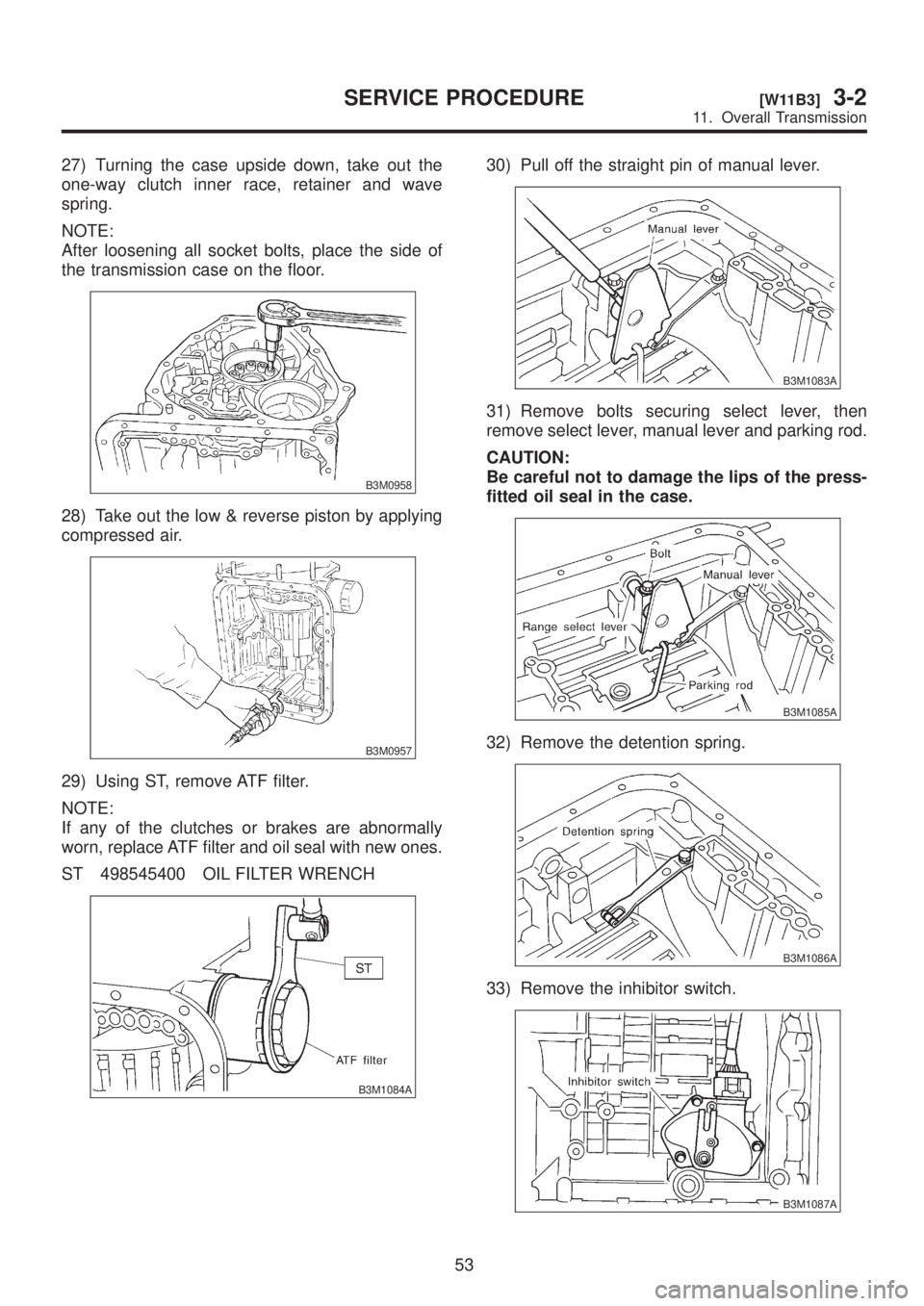
27) Turning the case upside down, take out the
one-way clutch inner race, retainer and wave
spring.
NOTE:
After loosening all socket bolts, place the side of
the transmission case on the floor.
B3M0958
28) Take out the low & reverse piston by applying
compressed air.
B3M0957
29) Using ST, remove ATF filter.
NOTE:
If any of the clutches or brakes are abnormally
worn, replace ATF filter and oil seal with new ones.
ST 498545400 OIL FILTER WRENCH
B3M1084A
30) Pull off the straight pin of manual lever.
B3M1083A
31) Remove bolts securing select lever, then
remove select lever, manual lever and parking rod.
CAUTION:
Be careful not to damage the lips of the press-
fitted oil seal in the case.
B3M1085A
32) Remove the detention spring.
B3M1086A
33) Remove the inhibitor switch.
B3M1087A
53
[W11B3]3-2SERVICE PROCEDURE
11. Overall Transmission
Page 600 of 1456
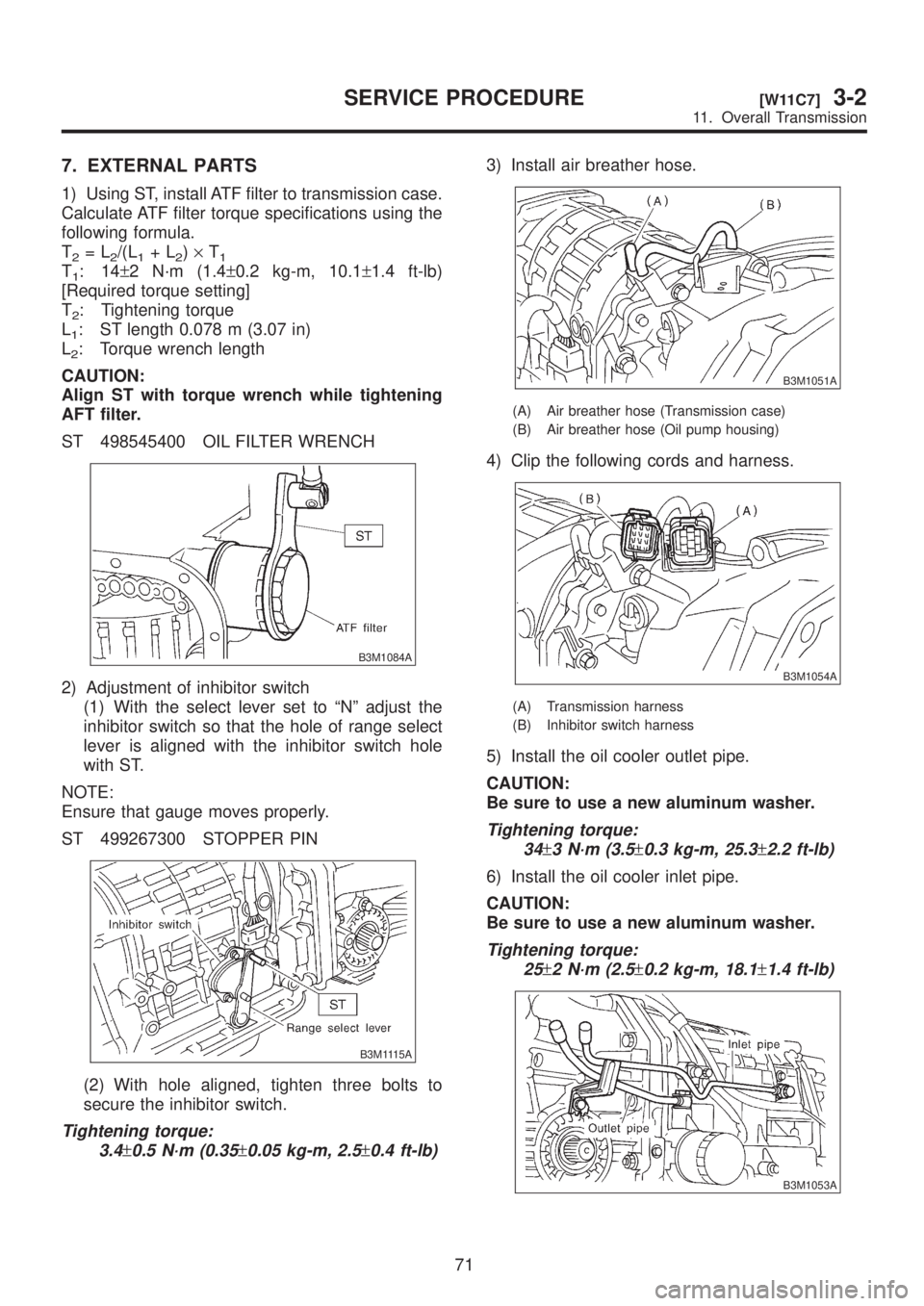
7. EXTERNAL PARTS
1) Using ST, install ATF filter to transmission case.
Calculate ATF filter torque specifications using the
following formula.
T
2=L2/(L1+L2)´T1T1:14±2 N´m (1.4±0.2 kg-m, 10.1±1.4 ft-lb)
[Required torque setting]
T
2: Tightening torque
L
1: ST length 0.078 m (3.07 in)
L
2: Torque wrench length
CAUTION:
Align ST with torque wrench while tightening
AFT filter.
ST 498545400 OIL FILTER WRENCH
B3M1084A
2) Adjustment of inhibitor switch
(1) With the select lever set to ªNº adjust the
inhibitor switch so that the hole of range select
lever is aligned with the inhibitor switch hole
with ST.
NOTE:
Ensure that gauge moves properly.
ST 499267300 STOPPER PIN
B3M1115A
(2) With hole aligned, tighten three bolts to
secure the inhibitor switch.
Tightening torque:
3.4
±0.5 N´m (0.35±0.05 kg-m, 2.5±0.4 ft-lb)
3) Install air breather hose.
B3M1051A
(A) Air breather hose (Transmission case)
(B) Air breather hose (Oil pump housing)
4) Clip the following cords and harness.
B3M1054A
(A) Transmission harness
(B) Inhibitor switch harness
5) Install the oil cooler outlet pipe.
CAUTION:
Be sure to use a new aluminum washer.
Tightening torque:
34
±3 N´m (3.5±0.3 kg-m, 25.3±2.2 ft-lb)
6) Install the oil cooler inlet pipe.
CAUTION:
Be sure to use a new aluminum washer.
Tightening torque:
25
±2 N´m (2.5±0.2 kg-m, 18.1±1.4 ft-lb)
B3M1053A
71
[W11C7]3-2SERVICE PROCEDURE
11. Overall Transmission
Page 995 of 1456
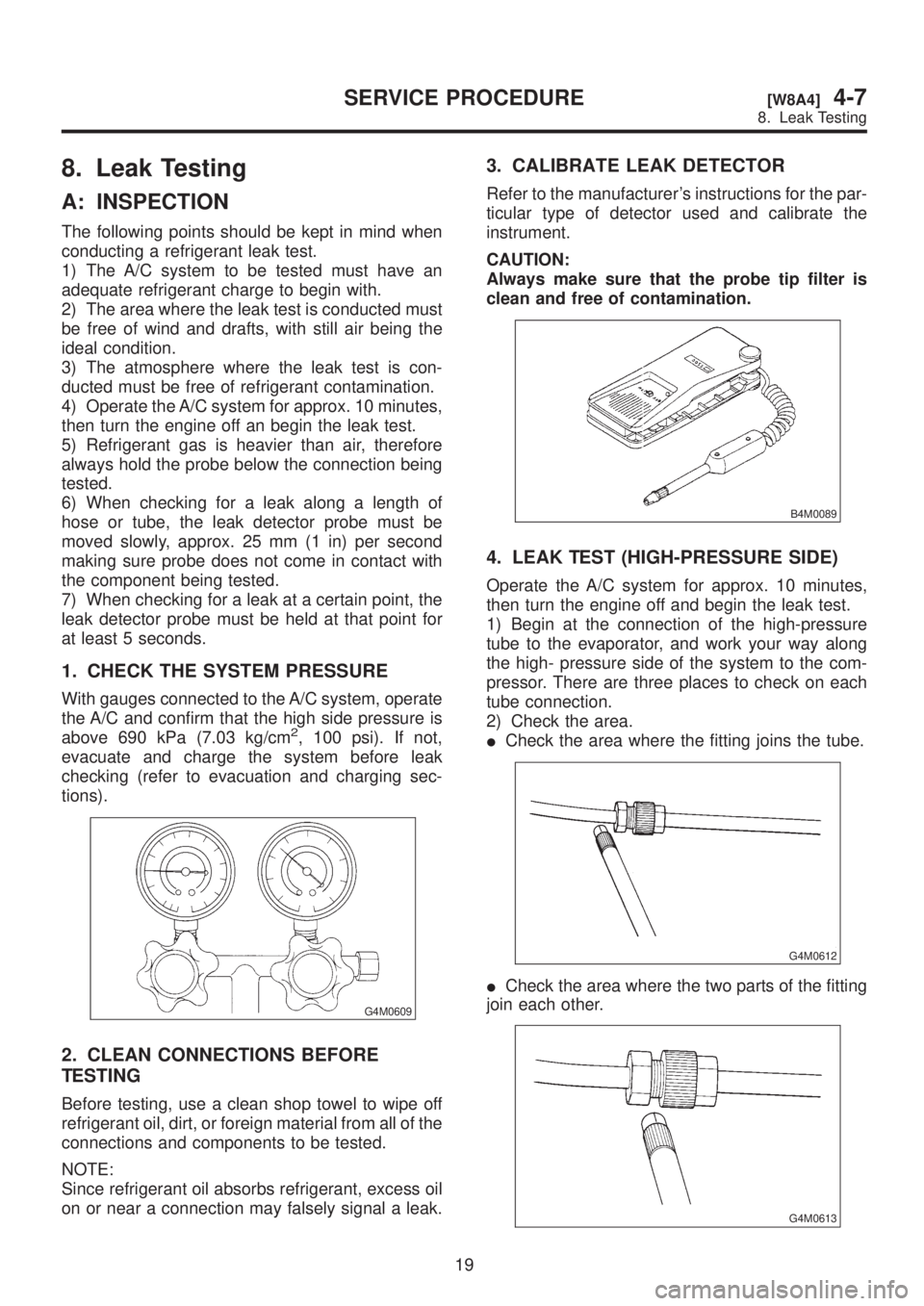
8. Leak Testing
A: INSPECTION
The following points should be kept in mind when
conducting a refrigerant leak test.
1) The A/C system to be tested must have an
adequate refrigerant charge to begin with.
2) The area where the leak test is conducted must
be free of wind and drafts, with still air being the
ideal condition.
3) The atmosphere where the leak test is con-
ducted must be free of refrigerant contamination.
4) Operate the A/C system for approx. 10 minutes,
then turn the engine off an begin the leak test.
5) Refrigerant gas is heavier than air, therefore
always hold the probe below the connection being
tested.
6) When checking for a leak along a length of
hose or tube, the leak detector probe must be
moved slowly, approx. 25 mm (1 in) per second
making sure probe does not come in contact with
the component being tested.
7) When checking for a leak at a certain point, the
leak detector probe must be held at that point for
at least 5 seconds.
1. CHECK THE SYSTEM PRESSURE
With gauges connected to the A/C system, operate
the A/C and confirm that the high side pressure is
above 690 kPa (7.03 kg/cm
2, 100 psi). If not,
evacuate and charge the system before leak
checking (refer to evacuation and charging sec-
tions).
G4M0609
2. CLEAN CONNECTIONS BEFORE
TESTING
Before testing, use a clean shop towel to wipe off
refrigerant oil, dirt, or foreign material from all of the
connections and components to be tested.
NOTE:
Since refrigerant oil absorbs refrigerant, excess oil
on or near a connection may falsely signal a leak.
3. CALIBRATE LEAK DETECTOR
Refer to the manufacturer's instructions for the par-
ticular type of detector used and calibrate the
instrument.
CAUTION:
Always make sure that the probe tip filter is
clean and free of contamination.
B4M0089
4. LEAK TEST (HIGH-PRESSURE SIDE)
Operate the A/C system for approx. 10 minutes,
then turn the engine off and begin the leak test.
1) Begin at the connection of the high-pressure
tube to the evaporator, and work your way along
the high- pressure side of the system to the com-
pressor. There are three places to check on each
tube connection.
2) Check the area.
ICheck the area where the fitting joins the tube.
G4M0612
ICheck the area where the two parts of the fitting
join each other.
G4M0613
19
[W8A4]4-7SERVICE PROCEDURE
8. Leak Testing